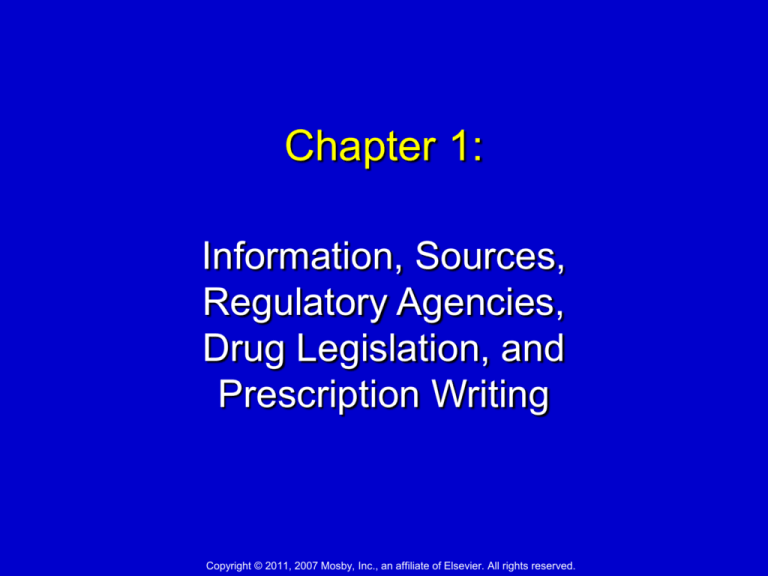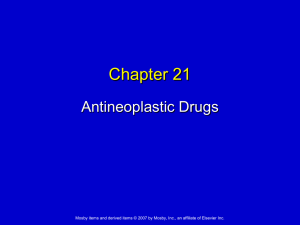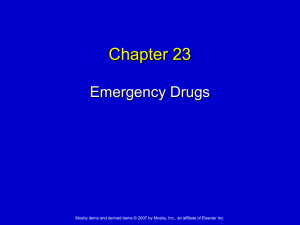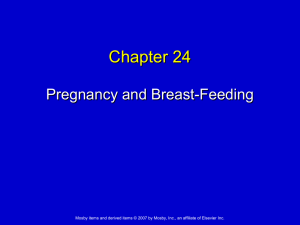
Chapter 1:
Information, Sources,
Regulatory Agencies,
Drug Legislation, and
Prescription Writing
Copyright © 2011, 2007 Mosby, Inc., an affiliate of Elsevier. All rights reserved.
Chapter 1 Outline
Information, Sources, Regulatory Agencies,
Drug Legislation, and Prescription Writing
History
Pharmacology and oral health care providers
Sources of information
Drug names
Federal regulations and regulatory agencies
Clinical evaluation of a new drug
Drug legislation
Prescription writing
Copyright © 2011, 2007 Mosby, Inc., an affiliate of Elsevier. All rights reserved.
2
Information, Sources, Regulatory
Agencies, Drug Legislation, and
Prescription Writing
Pharmacology
Haveles (p. 2)
Derived from Greek prefix pharmaco-, meaning
“drug” or “medicine,” and Greek suffix -logy,
meaning “study”
Dorland’s Illustrated Medical Dictionary
Any chemical compound used on or administered
to humans or animals as an aid in the diagnosis,
treatment, or prevention of disease or other
abnormal condition, for the relief of pain or
suffering, or to control or improve any physiologic
or pathologic condition
cont’d…
Copyright © 2011, 2007 Mosby, Inc., an affiliate of Elsevier. All rights reserved.
3
Information, Sources, Regulatory
Agencies, Drug Legislation, and
Prescription Writing
These definitions are not complete
Birth control pills are indicated for treatment of
which disease?
A large group of substances (drugs?) have
been categorized as “dietary supplements”
These substances may have pharmacologic
effects on the body, but by law are not classified
as drugs
This classification avoids U.S. Food and Drug
Administration (FDA) approval for efficacy and
safety required for drugs
Copyright © 2011, 2007 Mosby, Inc., an affiliate of Elsevier. All rights reserved.
4
History
Certain plants were found to alter body
functions or awareness
Haveles (pp. 2-3)
Observations were made about which plant
products produced predictable results
Useful agents are prescribed and dispensed
through medicine, dentistry, pharmacy, and
nursing
Copyright © 2011, 2007 Mosby, Inc., an affiliate of Elsevier. All rights reserved.
5
Pharmacology and Oral Health
Care Providers
Haveles (pp. 3-4) (Table 1-1)
Competencies are tasks that oral health care
providers should be able to perform
To perform each competency, certain facts or
concepts must be accessed
Decisions that surround performing a competency
depend on foundation knowledge
Thought, facts, reasoning, and problem solving
are involved in making decisions about each
patient
cont’d…
Copyright © 2011, 2007 Mosby, Inc., an affiliate of Elsevier. All rights reserved.
6
Pharmacology and Oral Health
Care Providers
Haveles (pp. 3-4)
Knowledge of pharmacology is required to
perform functions such as
Obtaining a health history
Administering drugs in the office
Handling emergency situations
Planning appointments
Nonprescription medication
Nutritional or herbal supplements
Discussing drugs
Life-long learning
Copyright © 2011, 2007 Mosby, Inc., an affiliate of Elsevier. All rights reserved.
7
Sources of Information
Sources include reference texts, association
journals, and the Internet
Haveles (pp. 4-6) (Tables 1-2, 1-3)
Each publication may be judged on lack of bias,
publication date, readability, degree of detail, and
price
Every dental office should have at least one
reference book that lists names of both
prescription and over-the-counter (OTC)
drugs
A standard pharmacology textbook would be
helpful in understanding the reference books
Copyright © 2011, 2007 Mosby, Inc., an affiliate of Elsevier. All rights reserved.
8
Selected Drug Information
References
Haveles (p. 5) (Table 1-2)
American Health-Systems Formulary Service
United States Pharmacopeia-Drug Information
(USP DI)
Drug Facts and Comparisons
Physicians’ Desk Reference (PDR)
Handbook of Nonprescription Drugs: An
Interactive Approach to Self-Care (OTC
Handbook)
PDR for Nonprescription Drugs, Supplements,
and Herbs
cont’d…
Copyright © 2011, 2007 Mosby, Inc., an affiliate of Elsevier. All rights reserved.
9
Selected Drug Information
References
PDR for Herbal Medicines
Natural Products: A Case-Based Approach for
Health Care Professionals
Merck Manual for Medical Information
Drug Interaction Facts
Mosby’s Dental Drug Reference
Lexi-Comp’s Drug Information Handbook for
Dentistry
Goodman and Gilman’s The Pharmacologic
Basis of Therapeutics
Copyright © 2011, 2007 Mosby, Inc., an affiliate of Elsevier. All rights reserved.
10
United States Pharmacopeia-Drug
Information (USP DI)
Volume 1: Drug Information for the Health
Care Provider
Provides the health professional with necessary
information regarding basic pharmacology and
pharmacokinetics, dosing, adverse reactions, and
drug interactions
Volume 2: Advice for the Patient
Includes appropriate information on
pharmacology, pharmacokinetics, dosing, adverse
reactions, and drug interactions
Copyright © 2011, 2007 Mosby, Inc., an affiliate of Elsevier. All rights reserved.
11
Physician's Desk Reference
(PDR)
Most common reference book in the dental
office
Information provided comes directly from the
manufacturer’s package insert
Manufacturers are listed alphabetically
Drugs are listed alphabetically within each
manufacturer’s section
Copyright © 2011, 2007 Mosby, Inc., an affiliate of Elsevier. All rights reserved.
12
Mosby’s Dental Drug Reference
Drugs are presented alphabetically by
generic name
Includes indications, contraindications, dental
considerations, and pharmacologic classification
An alphabetic cross-index offers access to both
brand and generic name drugs
Copyright © 2011, 2007 Mosby, Inc., an affiliate of Elsevier. All rights reserved.
13
Lexi-Comp’s Drug Information
Handbook for Dentistry
Contains concise lists of drug attributes and
sections relevant to dentistry for each drug
Each monograph contains up to 32 fields of
information, including dosage, local
anesthetic/vasoconstrictor precautions, drug
interactions, and effects on dental treatment
Copyright © 2011, 2007 Mosby, Inc., an affiliate of Elsevier. All rights reserved.
14
Drug Names
Haveles (pp. 4, 6)
All drugs have at least two names, and many
have more
Chemical name
• The name determined by the chemical structure of the
compound
• A code name may be used as well
cont’d…
Copyright © 2011, 2007 Mosby, Inc., an affiliate of Elsevier. All rights reserved.
15
Drug Names
Trade name
• The name given if a compound is found to be useful and
if the determination is made that it will be marketed
• Capitalized, usually chosen so it can be easily
remembered and promoted commercially
• Registered as a trademark, property of the registering
company
• Protected by Federal Patent Law for 20 years
cont’d…
Copyright © 2011, 2007 Mosby, Inc., an affiliate of Elsevier. All rights reserved.
16
Drug Names
Generic name
The “official” nonproprietary name given the drug
before it is marketed
Each drug has only one generic name
Selected by the U.S. Adopted Name Council
(USAN)
Not capitalized
cont’d…
Copyright © 2011, 2007 Mosby, Inc., an affiliate of Elsevier. All rights reserved.
17
Drug Names
Haveles (p. 6) (Fig. 1-1)
Example
Generic name: Lidocaine
• Only one name
• First letter lowercase
Trade name: Xylocaine, Octocaine
• More than one name
• First letter capitalized
cont’d…
Copyright © 2011, 2007 Mosby, Inc., an affiliate of Elsevier. All rights reserved.
18
Drug Names
Haveles (p. 4)
After the original manufacturer’s patent
expires, other companies can market the
generic drug under a trade name of their
choosing
When a patient states an allergy to a particular
trade name of a drug, the practitioner must know
the generic name of the drug so the patient is not
given another brand of the same generic drug
cont’d…
Copyright © 2011, 2007 Mosby, Inc., an affiliate of Elsevier. All rights reserved.
19
Drug Names
This book uses generic names because only
one generic name is given for each drug
Trade names (proprietary names) appear in
parentheses after the generic name
A problem occurs in naming multiple-entity
drugs
These drugs are difficult to discuss by generic
name because they contain several ingredients
Copyright © 2011, 2007 Mosby, Inc., an affiliate of Elsevier. All rights reserved.
20
Drug Substitution
Haveles (p. 6)
The question of generic equivalence and
substitution arises in the discussion of
generic and trade names
After 17 years, the patent of the original drug
expires, and other companies can market the
same compound under a generic name
cont’d…
Copyright © 2011, 2007 Mosby, Inc., an affiliate of Elsevier. All rights reserved.
21
Drug Substitution
In 1984, Congress passed the Drug Price
Competition and Patent Term Restoration Act,
which allowed generic drugs to receive
expedited approval
The FDA still requires the active ingredient of the
generic product to enter the bloodstream at the
same rate as the trade name product
cont’d…
Copyright © 2011, 2007 Mosby, Inc., an affiliate of Elsevier. All rights reserved.
22
Drug Substitution
Drugs can be judged “similar” in several ways
When two formulations of a drug meet the
chemical and physical standards established by
the regulatory agencies, they are termed
chemically equivalent
When the two formulations produce similar
concentrations of the drug in blood and tissues,
they are termed biologically equivalent
When the two formulations prove to have an equal
therapeutic effect in a clinical trial, they are termed
therapeutically equivalent
cont’d…
Copyright © 2011, 2007 Mosby, Inc., an affiliate of Elsevier. All rights reserved.
23
Drug Substitution
A preparation can be chemically equivalent
yet not biologically or therapeutically
equivalent
These products differ in bioavailability
Before generic drugs are marketed, they
must be shown to be biologically equivalent,
which would make them therapeutically
equivalent
Copyright © 2011, 2007 Mosby, Inc., an affiliate of Elsevier. All rights reserved.
24
Top 200 Drugs
Haveles (p. 6, Appendix A)
Appendix A lists the 200 drugs most often
prescribed in 2008
The rank order appears in the right column of the
appendix
This number represents the position that the drug
appears in the top 200
cont’d…
Copyright © 2011, 2007 Mosby, Inc., an affiliate of Elsevier. All rights reserved.
25
Top 200 Drugs
Both generic and trade names appear on the
list, depending on how the prescription is
written
The oral health care provider must become
familiar with these names because patients may
know the names of the drugs they are taking but
not know how the names are spelled
Accurate spelling permits the drugs to be
accessed in reference sources
Copyright © 2011, 2007 Mosby, Inc., an affiliate of Elsevier. All rights reserved.
26
Federal Regulations and
Regulatory Agencies
Haveles (pp. 6-7)
Many agencies are involved in regulating the
production, marketing, advertising, labeling,
and prescribing of drugs
Harrison Narcotic Act
U.S. Food and Drug Administration (FDA)
Federal Trade Commission (FTC)
Drug Enforcement Administration (DEA)
Omnibus Budget Reconciliation Act (OBRA)
Copyright © 2011, 2007 Mosby, Inc., an affiliate of Elsevier. All rights reserved.
27
Harrison Narcotic Act
Established regulations governing the used of
opium, opiates, and cocaine in 1914
Haveles (pp. 6-7)
Marijuana laws were added in 1937
Before this law, mixtures and OTC
medications could contain opium and cocaine
Copyright © 2011, 2007 Mosby, Inc., an affiliate of Elsevier. All rights reserved.
28
U.S. Food and Drug
Administration (FDA)
Haveles (p. 7)
Part of the U.S. Department of Health and
Human Services (USHHS)
Grants approval so that drugs can be marketed in
the United States
Requires physical and chemical standards for
specific products and quality control in drug
manufacturing plants
Determines which drugs can be sold by
prescription and OTC and regulates the labeling
and advertising of prescription drugs
Copyright © 2011, 2007 Mosby, Inc., an affiliate of Elsevier. All rights reserved.
29
Federal Trade Commission (FTC)
Haveles (p. 7)
Regulates the trade practices of drug
companies
Prohibits the false advertising of foods,
nonprescription (OTC) drugs, and cosmetics
Copyright © 2011, 2007 Mosby, Inc., an affiliate of Elsevier. All rights reserved.
30
Drug Enforcement Administration
(DEA)
Part of the Department of Justice
Administers the Controlled Substances Act of
1970
Regulates the manufacture and distribution of
substances that have a potential for abuse,
including opioids (narcotics), stimulants, and
sedatives
Copyright © 2011, 2007 Mosby, Inc., an affiliate of Elsevier. All rights reserved.
31
Omnibus Budget Reconciliation
Act (OBRA)
Pharmacists must provide patient counseling
and a prospective drug utilization review
(DUR) for Medicaid patients
Many state boards of pharmacy are interpreting
this law to apply to all patients
Dental patients who have their prescriptions
filled at a pharmacy should receive
counseling form the pharmacist about their
prescription
Copyright © 2011, 2007 Mosby, Inc., an affiliate of Elsevier. All rights reserved.
32
Clinical Evaluation of a New Drug
Haveles (p. 7) (Fig. 1-2)
A discovered or synthesized compound must
pass through many steps before it is
approved to become a marketed drug
Animal studies begin by measuring both acute and
chronic toxicity
The median lethal dose is determined for several
species of animals
cont’d…
Copyright © 2011, 2007 Mosby, Inc., an affiliate of Elsevier. All rights reserved.
33
Clinical Evaluation of a New Drug
Long-term animal studies continue, including
a search for teratogenic effects
Toxicity and pharmacokinetic properties are also
noted
An investigational new drug application (INDA)
must be filed before any clinical trials are
performed
Human studies involve four phases
cont’d…
Copyright © 2011, 2007 Mosby, Inc., an affiliate of Elsevier. All rights reserved.
34
Clinical Evaluation of a New Drug
Phase I
Small and then increasing doses are administered
to a limited number of healthy human volunteers
• Primarily to determine safety
Determines biologic effects, metabolism, safe
dose range in humans, and toxic effects of the
drug
cont’d…
Copyright © 2011, 2007 Mosby, Inc., an affiliate of Elsevier. All rights reserved.
35
Clinical Evaluation of a New Drug
Phase 2
Larger groups of humans are given the drug and
any adverse reactions are reported to the FDA
• Primarily to test effectiveness
cont’d…
Copyright © 2011, 2007 Mosby, Inc., an affiliate of Elsevier. All rights reserved.
36
Clinical Evaluation of a New Drug
Phase 3
More clinical evaluation takes place involving a
large number of patients who have the condition
for which the drug is indicated
• Both safety and efficacy must be demonstrated
• Dosage is determined
cont’d…
Copyright © 2011, 2007 Mosby, Inc., an affiliate of Elsevier. All rights reserved.
37
Clinical Evaluation of a New Drug
Phase 4
Postmarketing surveillance
• Toxicity that occurs in patients taking the drug after it is
released is recorded
• Several drugs in recent years have been removed from
the market only after phase 4 has shown serious toxicity
Copyright © 2011, 2007 Mosby, Inc., an affiliate of Elsevier. All rights reserved.
38
Drug Legislation
History
Food and Drug Act of 1906
Haveles (pp. 7-8)
The first federal law to regulate interstate
commerce in drugs
Harrison Narcotic Act of 1914
Provided federal control over narcotic drugs
Required registration of all practitioners
prescribing narcotics
cont’d…
Copyright © 2011, 2007 Mosby, Inc., an affiliate of Elsevier. All rights reserved.
39
Drug Legislation
Food, Drug, and Cosmetic Act of 1938
Prohibits interstate commerce of drugs not shown to
be safe and effective
Durham-Humphrey Law of 1952
Requires that certain types of drugs be sold only by
prescription
Requires the drugs be labeled “Caution: Federal law
prohibits dispensing without prescription”
Prohibits refilling a prescription unless directions to
the contrary are indicated on the prescription
cont’d…
Copyright © 2011, 2007 Mosby, Inc., an affiliate of Elsevier. All rights reserved.
40
Drug Legislation
Drug Amendments of 1962 (Kefauver-Harris
Bill)
Manufacturers were required to demonstrate the
effectiveness of drugs, to follow strict rules in
testing, and to submit to the FDA any reports of
adverse effects from drugs already on the market
Manufacturer’s were also required to list drug
ingredients by generic name in labeling and
advertising and to state adverse effects,
contraindications, and efficacy of a drug
cont’d…
Copyright © 2011, 2007 Mosby, Inc., an affiliate of Elsevier. All rights reserved.
41
Drug Legislation
Drug Abuse Control Amendments of 1965
Required accounting for drugs with a potential for
abuse, such as barbiturates and amphetamines
The Controlled Substance Act of 1970
Sets current requirements for writing prescriptions
for drugs often prescribed in dental practice
Copyright © 2011, 2007 Mosby, Inc., an affiliate of Elsevier. All rights reserved.
42
Scheduled Drugs
Haveles (p. 8) (Table 1-4)
Federal law divides controlled substances
into five schedules according to their abuse
potential
Rules differ depending on the drug’s schedule
New drug entities are evaluated and added to the
appropriate schedule
Drugs may be moved from one schedule to
another if changes in abuse patterns are
discovered
cont’d…
Copyright © 2011, 2007 Mosby, Inc., an affiliate of Elsevier. All rights reserved.
43
Scheduled Drugs
Current requirements for prescribing
controlled drugs
Any prescription for a controlled substance
requires a DEA number
All schedule II through IV drugs require a
prescription
cont’d…
Copyright © 2011, 2007 Mosby, Inc., an affiliate of Elsevier. All rights reserved.
44
Scheduled Drugs
Any prescription for schedule II drugs must be written
in pen or indelible ink or typed
• A designee may write the prescription, but the prescriber
must personally sign the prescription in ink and is responsible
for what the designee has written
Schedule II prescriptions cannot be telephoned to the
pharmacist (except at the discretion of the pharmacist
for an emergency supply to be followed by a written
prescription within 72 hours)
cont’d…
Copyright © 2011, 2007 Mosby, Inc., an affiliate of Elsevier. All rights reserved.
45
Scheduled Drugs
Because schedule II prescriptions cannot be refilled,
the patient must obtain a new written prescription to
obtain more medication
Certain states require the use of “triplicate” or
“duplicate” prescriptions for schedule II drugs
Prescriptions for schedule III and intravenous drugs
may be telephoned to the pharmacist and may be
refilled no more than five times in 6 months, if so
noted on the prescription
Copyright © 2011, 2007 Mosby, Inc., an affiliate of Elsevier. All rights reserved.
46
Prescription Writing
Measurement
Metric system
Household measures
Prescriptions
Haveles (pp. 8-11)
Format
Explanations accompanying prescriptions
cont’d…
Copyright © 2011, 2007 Mosby, Inc., an affiliate of Elsevier. All rights reserved.
47
Prescription Writing
Correctly written prescriptions will save time
Carefully written prescriptions are less likely
to result in mistakes
The dentist can save the patient’s and
pharmacist’s time with extra effort when
unusual prescriptions are written
Problems will be minimized if the unusual is
explained
Copyright © 2011, 2007 Mosby, Inc., an affiliate of Elsevier. All rights reserved.
48
Measurement
Haveles (p. 9)
Metric system
In pharmacy, the primary measuring system is the
metric system
Scientific calculations use a base of 10
• The metric system, based on 10, is the language of
scientific measurement
Only metric units should be used in scientific
measurement
cont’d…
Copyright © 2011, 2007 Mosby, Inc., an affiliate of Elsevier. All rights reserved.
49
Measurement
The basic metric unit for weight is the
kilogram (kg)
The basic metric unit for volume is the liter (L)
Haveles (p. 9) (Table 1-5)
One milliliter (ml), or one-thousandth of a liter, is
exactly 1 cubic centimeter (cc)
Solid drugs are dispensed by weight
(milligrams [mg]) and liquid drugs by volume
(milliliters [ml])
Copyright © 2011, 2007 Mosby, Inc., an affiliate of Elsevier. All rights reserved.
50
Household Measures
Clinicians direct the pharmacist to dispense a
liquid in milliliters
Haveles (p. 9)
It is generally converted by the pharmacist into
household measures to be included in directions
to the patient
Liquids are converted into teaspoonfuls (5 ml)
and tablespoons (15 ml)
A calibrated dosing cup should be used
Copyright © 2011, 2007 Mosby, Inc., an affiliate of Elsevier. All rights reserved.
51
Prescriptions
Haveles (pp. 9-11) (Fig. 1-3)
Format
The part of the prescription are divided into three
sections
• Heading
• Body
• Closing
Abbreviations
Copyright © 2011, 2007 Mosby, Inc., an affiliate of Elsevier. All rights reserved.
52
Heading
Haveles (p. 9)
Contains the following
Name, address, and telephone number of the
prescriber (printed on prescription blank)
Name, address, age, and telephone number of the
patient (written)
Date of the prescription
Copyright © 2011, 2007 Mosby, Inc., an affiliate of Elsevier. All rights reserved.
53
Body
The Rx symbol
Name and dose size or concentration
(liquids) of the drug
Amount to be dispensed
Haveles (pp. 9-10) (Fig. 1-3)
For tablets and capsules, “Dispense” is often
replaced with #, the symbol for a number
Directions to the patient
Preceded by the abbreviation Sig:
Copyright © 2011, 2007 Mosby, Inc., an affiliate of Elsevier. All rights reserved.
54
Closing
Prescriber's signature
DEA number, if required
Haveles (p. 10)
Needed for controlled substances
Often used by insurance companies as an
identifier
Refill instructions
cont’d…
Copyright © 2011, 2007 Mosby, Inc., an affiliate of Elsevier. All rights reserved.
55
Closing
Haveles (p. 10) (Fig. 1-4)
All prescriptions must be labeled with the name
of the medication and its strength
The name, address, and telephone number of the
pharmacy, the patient’s and dentist’s names, the
directions for use, the name and strength of the
medication, and the original date and the date filled
(refilled) are required
The quantity of medication dispensed and number of
refills remaining may be noted
cont’d…
Copyright © 2011, 2007 Mosby, Inc., an affiliate of Elsevier. All rights reserved.
56
Closing
Haveles (p. 11)
In most states, before a dentist can legally
write a prescription for a patient, the following
two criteria must be met
Patient of record: The person for whom the
prescription is being written is a patient of record
Dental condition: The condition for which the
prescription is being prescribed is a dental-related
condition
Copyright © 2011, 2007 Mosby, Inc., an affiliate of Elsevier. All rights reserved.
57
Abbreviations
Haveles (pp. 9, 11) (Table 1-5)
Used to save time but also makes alteration
of the prescription by a patient more difficult
ac: before meals
d: day
h: hour
hs: at bedtime
pc: after meals
cont’d…
Copyright © 2011, 2007 Mosby, Inc., an affiliate of Elsevier. All rights reserved.
58
Abbreviations
prn: as needed
sig: write (label)
stat: immediately
bid: twice per day
tid: three times per day
qid: four times per day
Copyright © 2011, 2007 Mosby, Inc., an affiliate of Elsevier. All rights reserved.
59
Explanations Accompanying
Prescriptions
Haveles (p. 11)
The dental health care worker should be able to
answer the patient’s questions about the
prescription
Make sure the patient knows how to take the
medication, what precautions to observe, and the
reason for taking the medication
Information about consequences of noncompliance
should be included
cont’d…
Copyright © 2011, 2007 Mosby, Inc., an affiliate of Elsevier. All rights reserved.
60
Explanations Accompanying
Prescriptions
The dental office should either keep a copy of
each prescription written in the patient’s
record or record the medication, dose, and
number prescribed
A patient should never get home and not know
which drug is the antibiotic and which is the
analgesic
Side effects should be noted on the label
cont’d…
Copyright © 2011, 2007 Mosby, Inc., an affiliate of Elsevier. All rights reserved.
61
Explanations Accompanying
Prescriptions
Prescription blanks should be kept in a
secure place
The dental health care worker should watch to see
they are not scattered around the office
Copyright © 2011, 2007 Mosby, Inc., an affiliate of Elsevier. All rights reserved.
62






